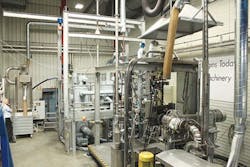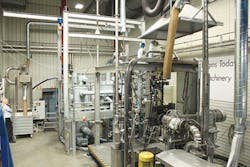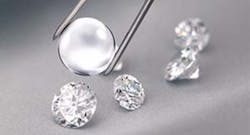Maag unveils way to make spherical, high-quality pellets
Maag Automatik Inc., Charlotte, N.C., a manufacturer of gear pumps, pelletizing systems and filtration systems, has developed a new underwater pelletizing process to produce high-quality pellets from technical thermoplastics.
Its Optimized Temperature Pelletizing (OTP) process cuts technical plastics into spherical pellets, minimizing the production of off-spec pellets or pellets with voids, dents or other defects. High-quality geometrically spherical pellets experience less wear during transportation compared to other geometries, says Maag. Lower wear reduces dust formation and the need for dust removal.
The pellets meet the standards for plastics used in medical applications. With OTP, technical materials can be made into flawless round pellets suited to optical applications such as lenses and screens, and automotive uses, including panorama roofs or engine parts.
The closed-loop OTP process eliminates several downstream pieces of equipment that are installed with conventional frequently strand pelletizing systems, including a fluidized bed, pneumatic conveyor, material classifier and a crystallization unit. Eliminating the downstream equipment shrinks the space required for the molding cell.
CLOSED-LOOP PELLETIZING
The OTP process works on Maag's Sphero underwater pelletizing line. The Sphero series comprises seven models that process from 220 to 79,200 pounds of material per hour. Its features include optimum water flow within the cutting chamber combined with a unique knife-head design that yields high-quality pellets. Users can select a die-plate design that is electrically heated, liquid heated or thermally isolated with its SuperFlow die plate. The Sphero underwater pelletizing line is offered with manual pressure adjustment or pneumatic pressure control for optimal process stability and reliability, says Maag.
OTP uses a dual-temperature circuit, configured as a hot-water circuit that handles the melt and a cold-water circuit that handles the pellets.
In the presence of the overheated water, which has been pressurized so it remains liquid above the boiling point in the hot-water circuit, the material is cut into pellets. Then the pellets are subject to a cooling step where temperatures in the hot-water circuit range from greater than 545 degrees down to 320 degrees Fahrenheit. An internal material transfer system transports the pellets from the hot-water circuit into a second, cold-water circuit. Operating temperature in the cold-water circuit ranges from about 203 degrees to less than 128 degrees Fahrenheit to further cool the pellet.
After final cooling, pressure is released and the pellets are separated from the process water using Maag's Centro series dryer. When the pellets leave the dryer they are ready for packing or other subsequent processing. OTP results in pellets that "shine like diamonds, with no voids, dents or defects," Maag says.
Maag successfully performed laboratory trials with PC, PET, polymethyl methacrylate and cyclic olefin copolymer. OTP can process PEEK, PPS, polyester, PC, polyacetals and other polymers. Until now, three major fields of application have been identified: materials for optical applications, like PC; high-temperature thermoplastics, like PEEK; and semi-crystalline polymers, like PET.
The OTP process operates in a closed-loop fashion, which isolates operating conditions from the surrounding environment, ensuring no emissions or contamination of the product. Maag says that energy from creating the higher temperature in the first cooling circuit could be used for heating purposes or transformed into electrical power suitable for use by pumps or motors on the system.
Mikell Knights, senior correspondent
Contact:
Maag Automatik Inc., 704-716-9000, www.maag.com


